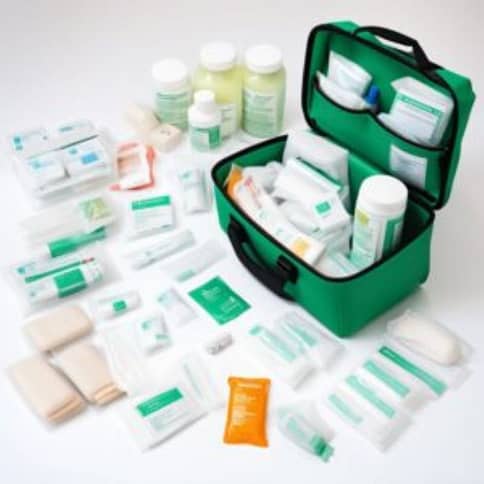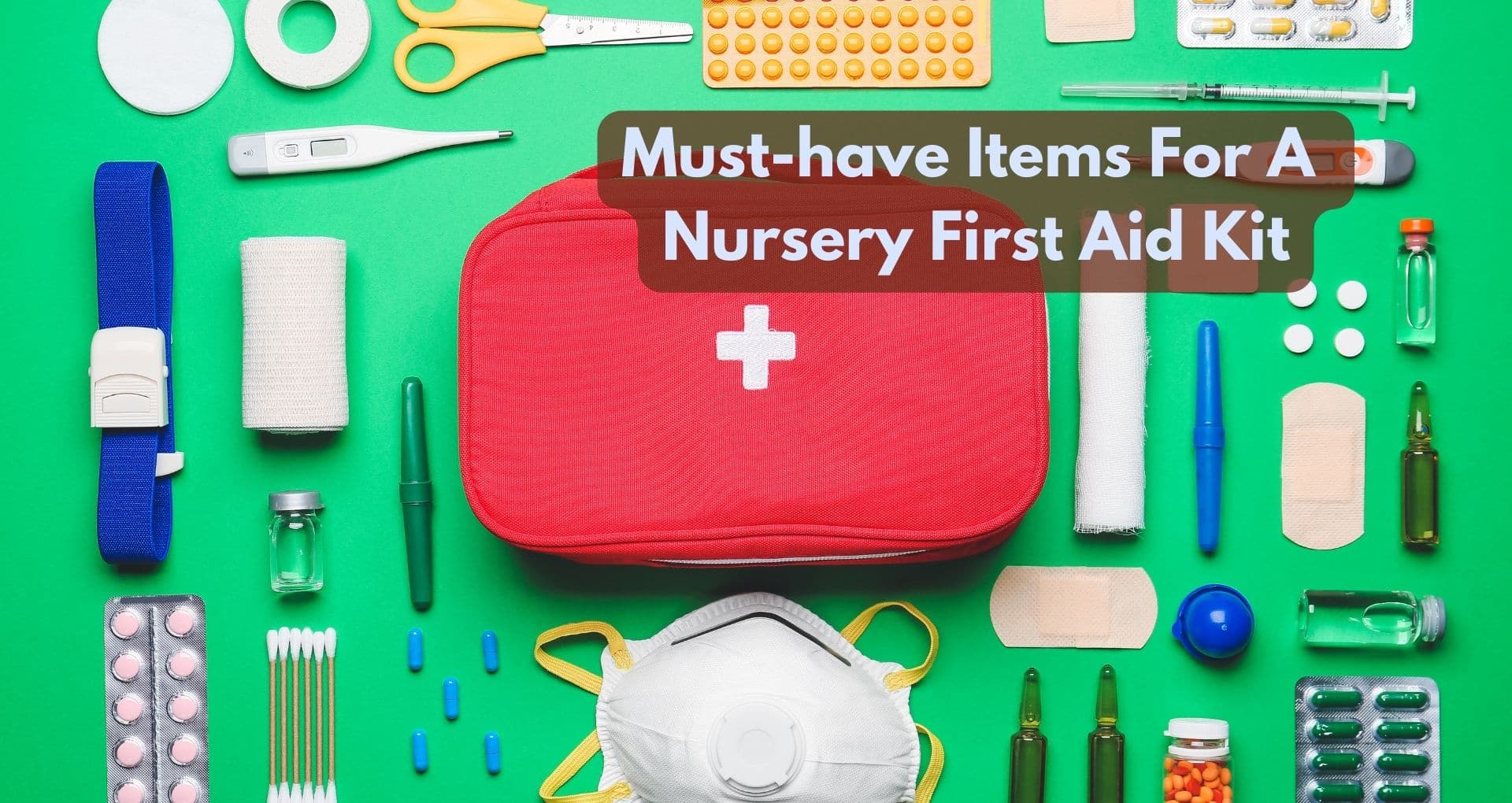Having a well-stocked nursery first aid kit is essential for any parent or caregiver. Accidents and emergencies can happen unexpectedly, so being prepared is key.
But what exactly should be included in a nursery first aid kit? From band-aids to thermometer and saline nasal drops, this article will guide you through the essential items to have on hand to ensure the safety and well-being of your little one.
Bandages
Adhesive bandages
Adhesive bandages, also known as band-aids, are one of the essential items you should have in your nursery first aid kit. These bandages are designed to cover and protect minor cuts, scrapes, and blisters. They have a sticky adhesive backing that holds them securely in place, ensuring that the wound remains clean and free from dirt or bacteria. Adhesive bandages come in different sizes, making them suitable for various types of injuries, from small cuts to larger wounds. Remember, it is always a good idea to have a variety of sizes and shapes of adhesive bandages in your nursery first aid kit to be prepared for any situation.
Gauze bandages
Gauze bandages are another must-have item for your nursery first aid kit. These bandages are made of a loose, woven material that allows for better air circulation around the wound. They are ideal for larger wounds that may require more coverage than an adhesive bandage can provide. Gauze bandages can be used in combination with adhesive bandages or other dressings to secure the wound and promote a faster healing process. They are highly absorbent and can help to control bleeding. Additionally, gauze bandages are versatile and can be easily cut to fit the size and shape of the wound, providing a customizable solution for various injuries.
Elastic bandages
Elastic bandages are an essential item for a nursery first aid kit, especially when it comes to treating sprains, strains, or other joint injuries. These bandages are made of stretchable material that provides compression and support to the injured area. By applying an elastic bandage firmly around the affected joint, you can reduce swelling, immobilize the area, and promote the healing process. Elastic bandages are easy to use and come in various sizes, making them a valuable addition to your nursery first aid kit.
Antiseptics
Antibacterial ointment
Antibacterial ointment is a crucial item to include in your nursery first aid kit to clean and protect wounds from infection. Apply antibacterial ointment to a wound to prevent bacterial entry and complications. This ointment contains active ingredients that kill or inhibit the growth of bacteria, providing an additional layer of defense against infection. It’s important to note that antibacterial ointment should not be used on deep wounds, severe burns, or puncture wounds. In such cases, it is best to seek medical attention.
Antiseptic wipes
Antiseptic wipes are convenient and practical for cleaning minor cuts or scrapes when access to water and soap is limited. These pre-moistened wipes are infused with antiseptic solutions that kill bacteria and reduce the risk of infection. Antiseptic wipes are individually packaged, making them portable and easily accessible whenever you need to clean a wound on the go. They are gentle on the skin and do not cause irritation, making them suitable for children. Including antiseptic wipes in your nursery first aid kit ensures that you can clean and disinfect minor wounds effectively.
Also Check: What Are The Benefits Of Using Baby Jumpers Or Exersaucers?
Medications
Fever reducer/pain reliever
A fever reducer and pain reliever is a must-have medication in your nursery first aid kit. Child-friendly versions of acetaminophen or ibuprofen are readily available over the counter and can help you manage your child’s discomfort caused by fever, headache, muscle aches, or toothaches. Remember, It’s essential to consult with your pediatrician or pharmacist to determine the appropriate dosage based on your child’s age and weight. Moreover, including a fever reducer and pain reliever in your nursery first aid kit aids in immediate relief for your child.
Antihistamine
Allergies can strike at any time, so having an antihistamine on hand in your nursery first aid kit is essential. Antihistamines help alleviate allergy symptoms such as sneezing, itching, runny nose, and watery eyes. They can also help reduce the severity of reactions to insect bites and stings. However, it is important to consult with your pediatrician before administering any antihistamine to your child, as the appropriate type and dosage may vary based on their age and weight. Include antihistamine in your nursery first aid kit for quick allergy relief and peace of mind.
Cough syrup
Cough syrup is a helpful medication to have in your nursery first aid kit to provide relief for your child’s cough and cold symptoms. Depending on the age of your child, you can choose an appropriate cough syrup that is specifically formulated for children. Cough syrups contain active ingredients that can soothe a sore throat and suppress coughing. Carefully follow the dosage instructions on the packaging or consult with your pediatrician for accurate dosing. Including cough syrup in your first aid kit helps alleviate your child’s discomfort during cough and cold.

Source: TheTechBrain AI
Thermometer
Digital thermometer
A digital thermometer is an essential tool for monitoring your child’s body temperature accurately. It allows you to quickly and easily measure your child’s temperature, providing valuable information for assessing their health. Digital thermometers are safe, reliable, and can provide readings within a matter of seconds. Moreover, they are designed to be gentle on children, featuring a flexible tip for added comfort and safety. Including a digital thermometer in your nursery first aid kit lets you monitor your child’s temperature during illness or for regular check-ups.
Forehead thermometer
A forehead thermometer is an alternative option to consider including in your nursery first aid kit. This type of thermometer is non-invasive and provides quick temperature readings by simply swiping it across your child’s forehead. Forehead thermometers use infrared technology to measure the heat radiated from the temporal artery in the forehead, providing an accurate estimation of body temperature. They are particularly useful for infants and young children who may be less tolerant of traditional thermometers. A forehead thermometer in your first aid kit helps monitor your child’s temperature conveniently and reliably.
Tweezers
Scissors
Having a pair of scissors in your nursery first aid kit is essential for cutting bandages, gauze, or other medical supplies as needed. Scissors with rounded tips are recommended to ensure the safety of both the person administering first aid and the patient. Rounded-tip scissors minimize the risk of accidental injury, especially when working with children who may make sudden movements. Additionally, including a pair of scissors in your first aid kit allows you to easily and safely customize bandages and dressings to fit the size and shape of various wounds.
Gloves
Gloves are an important item to include in your nursery first aid kit to protect both yourself and your child from potential contamination. They create a barrier between your hands and bodily fluids, reducing the risk of infection or the transmission of germs. Choose latex, nitrile, or vinyl disposable gloves based on allergies or sensitivities. Gloves should be worn when tending to wounds, administering medications, or handling any bodily fluids. Moreover, disposable gloves maintain hygiene and safety in your nursery first aid kit.
First aid manual
A first aid manual is an invaluable resource to include in your nursery first aid kit. It provides essential guidance on how to respond to common injuries, accidents, or medical emergencies. The manual offers step-by-step instructions for administering first aid and may include illustrations to help clarify procedures. Familiarizing yourself with the manual before an emergency occurs gives you the knowledge and confidence to respond appropriately. Including a first aid manual in your nursery first aid kit provides a reliable source of information whenever you need it.
Emergency contact information
In case of an emergency, having a printed list of emergency contact information is crucial. Include pediatrician’s office, local emergency services, and other relevant contacts in your list of important phone numbers. It is also essential to include your child’s full name, date of birth, and any relevant medical information or allergies. Including contact details and accurate information in your nursery first aid kit ensures quick access during emergencies.
Poison control hotline number
It is important to include the poison control hotline number in your nursery first aid kit. Young children’s curiosity can lead to accidental ingestion of household chemicals, medications, or other toxic substances. The poison control hotline provides immediate access to experts who can guide you through potentially life-saving measures to take in case of poisoning. Additionally, including the poison control hotline number in your nursery first aid kit ensures that you have immediate access to professional advice and assistance during such emergencies.
Conclusion
A well-stocked nursery first aid kit is essential for ensuring the safety and well-being of your child. Include bandages, antiseptics, medications, thermometer, tweezers, scissors, gloves, first aid manual, emergency contact info, and poison control hotline for comprehensive preparedness. Regularly check and refill your nursery first aid kit to keep items up to date and accessible. Remember, when it comes to your child’s health, it is always better to be prepared than caught off guard.
